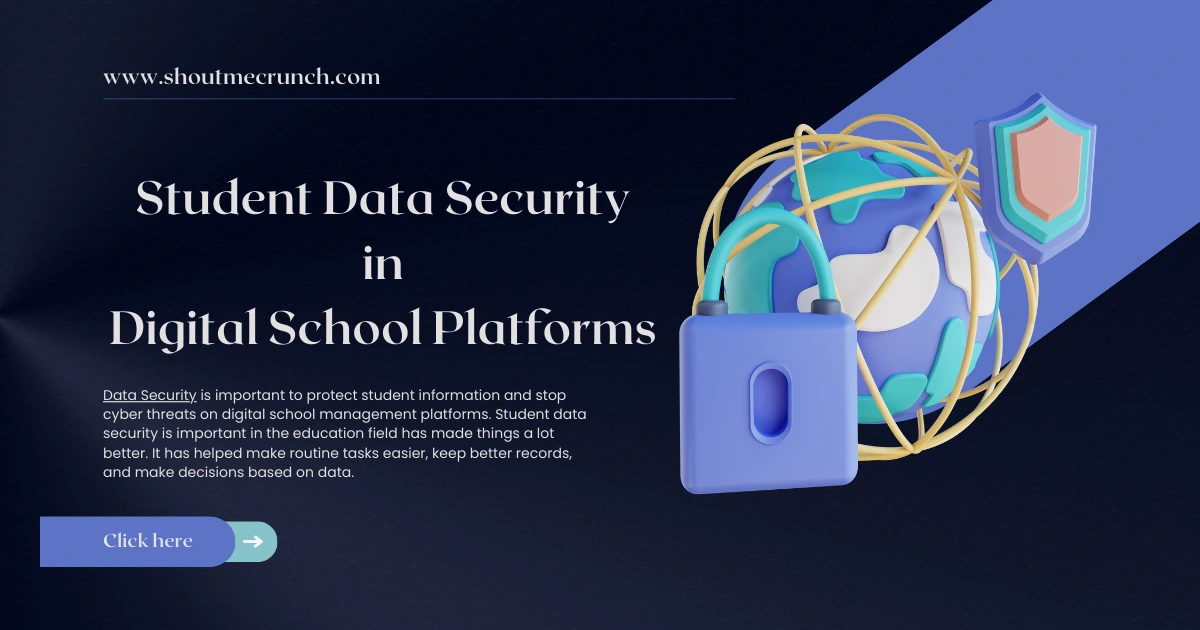Data Security is important to protect student information and stop cyber threats on digital school management platforms. Student data security is important in the education field has made things a lot better. It has helped make routine tasks easier, keep better records, and make decisions based on data.
However, as schools move to online systems, new hacking risks appear that must be dealt with. Any school that sets up a management tool should keep sensitive student data safe. Let’s talk about what a school can do to save student information from getting out.
Why protecting student data is important
Personal information about students, such as names, dates of birth, addresses, social security numbers, grades, and health conditions, can be gathered and stored in digital forms.
If this information is stolen during a cyberattack, students could lose their identities, hurt their reputations, be blackmailed, or fall for scams. Parents and kids trust schools that they must protect student information in any way. Students could lose their identities, hurt their reputations, be blackmailed, or fall for scams if this information is stolen in a cyberattack. Schools must keep student information safe so parents and kids can trust them.
Some of the key reasons proper data security measures are critical:
- Compliance with Data Protection Laws: Schools must comply with FERPA, COPPA, and other laws governing student data privacy and security. Negligence can result in heavy penalties.
- Avoid Reputational Damage: A data breach can severely damage an institution’s reputation and public image if cybersecurity is considered lax. This can impact enrollment numbers.
- Prevent Financial Loss: Compromised student records can lead to fraud, such as unauthorized applications for loans or aid using a student’s identity.
- Minimize Disruption: A security incident can disrupt normal school operations if systems are taken offline, preventing access to critical information.
Common Cyber Threats to School Data Systems
Some of the typical cybersecurity risks faced by school management platforms include:
- Phishing Attacks: Fraudulent emails or sites tricking staff into revealing passwords or downloading malware. Education data is a prime target for phishing.
- Insufficient Access Controls: Students or unauthorized third parties accessing data they should not have permission to view.
- Weak Passwords: Using guessable passwords or failing to change defaults makes systems vulnerable.
- Unpatched Software: Outdated platforms and apps that lack the latest security fixes are easier to infiltrate.
- Denial-of-Service (DoS): Cyberattacks that overload systems and servers, making them unavailable by flooding them with requests.
- SQL Injection: Inserting malicious code into a database query to extract, delete, or corrupt information.
- External apps or service providers: can compromise student data if they have inadequate security. This is a risk of sharing third-party data leaks.
Securing School Management Platforms
Schools can manage cyber risks and secure sensitive student data by taking the following security measures:
Choose a Secure Platform
- There are lots of school ERP programs available in the market; however not all of them are good. So, it is suggested to pick a good cloud based school management system like Quick Campus that offers robust cybersecurity controls built-in.
- Preference cloud-hosted solutions which have enterprise-grade security expertise and resources.
- Require third-party audits and compliance reports from vendors to validate security posture.
Limit Data Collection
- Only collect the minimum student information required for the school’s needs. Avoid unnecessary storage of data.
- Anonymize or pseudonymize data where possible for analytics/reporting purposes.
Control Access
- Restrict access to confidential data to only authorized staff requiring it.
- Implement role-based access control and equipment privilege management to limit access.
- Immediately revoke access when staff leave the institution.
- Use multi-factor authentication to secure staff accounts.
Create Strong Passwords
- Enforce strong password policies requiring minimum length, complexity, frequent changes, and prohibition of defaults.
- Educate staff on password hygiene principles and risks.
- Use a password manager to generate and store difficult random passwords.
Install Security Updates
- Enable auto-updates on all software and firmware. Prioritize deploying security patches.
- Regularly update operating systems, browsers, apps, and network devices to the latest secure versions.
Use Encryption
- Encrypt data in transit and at rest using protocols like SSL/TLS and database encryption schemes.
- Encrypt sensitive data like health records, disabilities, and counseling notes with more protection.
Monitor and Audit Activity
- Use data loss prevention tools to detect potential unauthorized access attempts.
- Continuously monitor networks for irregular behavior that may indicate a breach.
- Conduct periodic audits to identify security gaps and ensure compliance.
Educate End Users
- Provide cybersecurity and data privacy training to teachers and staff to raise awareness.
- Ensure everyone understands protocols like password policies, suspicious emails, and safe web use.
Create an Incident Response Plan
- Have a formal cybersecurity incident response plan for reporting, containing, and recovering from potential breaches.
- Notify students, parents, authorities, and other stakeholders promptly in case of a confirmed incident.
- Review causes and failures to prevent similar future occurrences.
Tips for Schools to Enhance Cybersecurity
Schools can take additional steps to strengthen their cyber defenses:
- Hire dedicated IT security staff to monitor systems, enforce policies, and respond to threats.
- Conduct frequent simulated ‘ethical hacking’ tests to uncover weaknesses.
- Install advanced threat detection solutions like antivirus, firewalls, intrusion detection, and email filtering.
- Back up critical data regularly and keep copies offline and isolated from networks.
- Provide secure remote learning platforms and VPN access to limit exposure.
- Create a stringent BYOD (bring your own device) policy for student devices accessing school networks.
- Develop a social media and mobile app policy for staff regarding student data.
- Limit connectivity and disable unused port or device features to reduce the attack surface.
- Segregate school systems into discrete networks to limit lateral movement after a breach.
- Require cyber insurance to cover recovery costs, liability, and notifications in case of an incident.
What student data is protected by federal privacy laws?
The Family Educational Rights and Privacy Act (FERPA) protects students’ education records from unauthorized disclosure. Education records may include grades, enrollment status, student ID number, and other information as long as they do not reveal the identity of a specific student. The schools can tell each other nothing without the parents’ permission.
What steps can parents take to ensure their child’s data is safe?
Parents can ask schools about their security policies, cyber training for staff, use of encryption, and limiting data collection only to required fields. Avoiding privacy risks can reassure parents.
What should school IT teams monitor to detect potential threats?
IT security staff should monitor networks for traffic spikes and connection attempts from unfamiliar locations, anomalies in transfers or downloads, phishing emails, suspicious domain visits, and unauthorized deletions or modifications of files.
Conclusion
Data Security is imperative as schools adopt digitized management systems and online platforms. Cyber threats pose a serious risk, but schools can mitigate dangers and comply with privacy laws through defense-in-depth security measures like encryption, access controls, updating software, IT security staffing, and comprehensive incident response plans.
Ongoing training, testing security, limiting data collection, and implementing good identity and access management practices will help schools secure student information.


